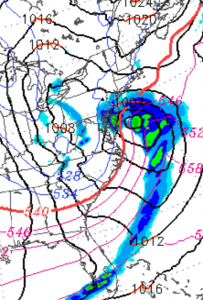An interesting and little known thing happens with weather forecasts on the evening TV newscasts when Daylight Saving Time is in effect. (Eastern Time)
Hmm….you’re thinking, what could that possibly be?
So let me cut to the chase and then I’ll explain.
When you watch the 10PM or 11PM news/weather on TV and you’re on Eastern Daylight Saving Time, the latest major weather models (with the exception of the NAM) are not available until after the broadcast is over!
Essentially, we’re all getting forecasts that are still based on radiosonde measurement and global model forecasts that were done earlier that day! You’re not getting the latest at 11 to 11:30 PM simply because the major models (GFS, European, Canadian) aren’t done being calculated by the supercomputers!
It doesn’t make a difference whether you’re watching Accuweather on Channel 6 or whatever they call it on Channels 3 and Channel 10. It’s simply not available on Eastern Daylight Savings Time until after the broadcast.
This is a peculiarity resulting from Eastern Daylight Time, (not Central or Pacific Daylight Saving Time) combined with how long it takes for the models to be computed.
More specifically, the earliest GFS data is available between 11:32 and 11:39 EDT. (Before we make the switch to Daylight Saving Time it’s available 10:32 and 10:39 EST. )
Update: With GFS version 16 that became operational in March 2020, the increase in complexity of the model has the availability time even later, about 10:45 EST and 11:45 PM DST. And that’s only for the 24 hour forecast. The five day forecast is first available about 11:20 PM EST and 12:20 AM DST!
And that’s just the forecast for the first 24 hours!
Here’s some more info: Most of the major models are run every 6 or 12 hours, starting with 00 UTC (previously called Greenwich Mean Time).
00 UTC = 7 PM Eastern Standard Time but it is 8 PM during Eastern Daylight Time.
Since the major models take a minimum of 3.5 hours to chew through the numbers, even on the supercomputers, it’s not until after 11:30 EDT when the first “24 hour products” of the major models first become available.
Even hourly short range models use the major models as starting points, so they’re affected too!
If you’re a weather nerd, here’s the site where you can see what time each of the model outputs are going to become available each day. (It’s sort of the on-time train schedule for US weather computer models.)
So during the warmer months on the east coast, when you hear one forecast on the late news and then wake up to hearing another forecast, this is one reason why!

